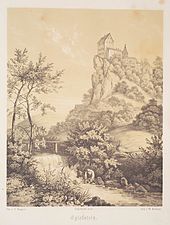History
The earliest record of the lords of Egloffstein dates from 1180. The castle was first mentioned in 1358, when Albert II of Egloffstein and his brothers founded a chaplaincy there, but it is probably older than that. The lords of Egloffstein initially owned the castle as an allod.
In 1372, during a feud with the Bishop of Bamberg, Götz von Egloffstein returned to his family castle at Egloffstein after the destruction of Leienfels Castle, which also belonged to him. In order to avoid Egloffstein Castle being besieged by the Bishop of Bamberg, Götz was excluded from the family association in 1374.
In 1376 the Bishop of Bamberg, Lamprecht of Brunn (1374–1398) forced Seybot II von Egloffstein to grant Öffnungsrecht to the Bishopric in the majority of the castle.
During the First Margrave War in 1449/50 the castle was attacked unsuccessfully by troops of Margrave Albert Achilles on 8 April 1450, but it was nevertheless badly damaged. From 1482 to 1493 it was considerably remodelled.
In 1509, Jobst I of Egloffstein gave up his portion of the castle to the Prince-Bishopric of Bamberg as a fief. In 1516 Wolf I of Egloffstein gave up the last remaining freehold element of the castle in family hands to the Prince-Bishopric as a fief. The reason was probably to do with the financial plight of the lords of Egloffstein.
In spite of the constant reinforcement of its defences the castle was conquered by Nuremberg troops during the War of the Succession of Landshut in 1504 and partly razed. Scarcely had it been rebuilt when, in 1525, it became a victim of the German Peasants' War. Its rebuilding thereafter was only partial and very slow.
During the conflict between William III of Egloffstein and the Bishop of Bamberg, Veit II of Würtzburg (1561–1577), the latter had the castle occupied and ravaged in 1563.
When the village of Egloffstein was raided by the Swedes in 1632 and 1645 during the Thirty Years' War, the castle suffered severe damage necessitating comprehensive rebuilding work. In 1664, Albert Christopher of Egloffstein had a large battery tower (Geschützturm) built.
In 1703, the castle survived its last warlike occupation during the War of the Spanish Succession without great damage. Likewise, the castle suffered no destruction in the succeeding decades.
In 1750 the brothers, Albert Christopher Charles and Louis I of Egloffstein built the present parish church of St. Bartholomew in place of the lower cabinet and its old castle chapel. In 1800, the great battery tower collapsed and was carried away.
The so-called patrimonial courts (Patrimonialgericht) at Egloffstein Castle over which its free nobles presided continued until 1848. Today, the castle still belongs to the barons of Egloffstein who have also owned Kunreuth Castle since the 14th century.

Franconian Switzerland is an upland in Upper Franconia, Bavaria, Germany and a popular tourist retreat. Located between the River Pegnitz in the east and the south, the River Regnitz in the west and the River Main in the north, its relief, which reaches 600 metres in height, forms the northern part of the Franconian Jura (Frankenjura). Like several other mountainous landscapes in the German-speaking lands, e.g. Holstein Switzerland, Märkische Schweiz, or Pommersche Schweiz, Franconian Switzerland was given its name by Romantic artists and poets in the 19th century who compared the landscape to Switzerland. Franconian Switzerland is famous for its high density of traditional breweries.
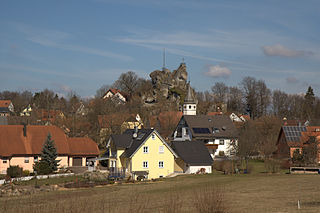
Wichsenstein Castle was a hill castle, once owned by noblemen, on a steep and prominent rock reef (Felsriff) outcrop above the church village of Wichsenstein in the Upper Franconian county of Forchheim in Bavaria, Germany. The castle has been completely demolished and there are no visible remains. The castle rock is now just used as a viewing point.

Pottenstein Castle is one of the oldest castles in Franconian Switzerland, a region in the German state of Bavaria. It stands on a rock above the eponymous town of Pottenstein in the Upper Franconian county of Bayreuth. The castle is home to a museum and both may be visited for a fee.

Gößweinstein Castle, also called Schloss Gößweinstein, is a mediaeval hilltop castle in Gößweinstein in the county of Forchheim in the German state of Bavaria. It towers high above the market town and the River Wiesent and may have been the inspiration for Richard Wagner's grail castle in his opera, Parsifal. The castle is a Bavarian listed building, no. D-4-74-129-10.

Kohlstein Castle is situated on a rocky hillock in the village of Kohlstein northwest of Tüchersfeld and is the most recently built castle in Franconian Switzerland. It is also one of the smallest and most romantic castles. Today it is in private ownership and may not be visited.

The ruins of Upper Tüchersfeld Castle are all that remains of a high medieval castle that once rose high above the valley of the Püttlach in the church village of Tüchersfeld in Germany's Franconian Switzerland. It was built on a spur of the Mittelberg and was one of two castles in the village, the other being the Lower Tüchersfeld Castle.

Neideck Castle is a former high mediaeval nobleman's castle above the village of Streitberg, in the municipality of Wiesenttal in the Upper Franconian county of Forchheim in the German state of Bavaria. As a result of its exposed location above the valley of the Wiesent, it has become a symbol of Franconian Switzerland.

Leienfels Castle was a late mediaeval aristocratic castle, immediately northwest of the eponymous village of Leienfels in the region of Franconian Switzerland in Germany. The village belongs to the borough of Pottenstein in the Upper Franconian county of Bayreuth in Bavaria.

The ruins of Bärnfels Castle are the remains of a late mediaeval aristocratic castle on the southern edge of the village of Bärnfels in the municipality of Obertrubach in the Upper Franconian county of Forchheim in Bavaria. The ruins of the spur castle are freely accessible.

Rabeneck Castle is a former high mediaeval aristocratic castle which stands high above the valley of the Wiesent in the Upper Franconian district of Bayreuth in the German state of Bavaria.

Waischenfeld Castle is a ruined rock castle on a rocky plateau a few metres west of the town of Waischenfeld in the province of Upper Franconia in the German state of Bavaria.
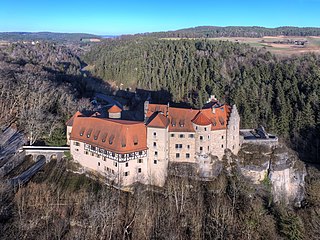
Rabenstein Castle is a former high medieval aristocratic castle in the municipality of Ahorntal in the Upper Franconian county of Bayreuth in the German state of Bavaria.

The ruins of Wolfsberg Castle are the remains of a former high mediaeval, aristocratic, castle which stands high above the Trubach valley over the eponymous village of Wolfsberg. The village is part of the municipality of Obertrubach in the Upper Franconian county of Forchheim in the German state of Bavaria.

Thuisbrunn Castle is located centrally within the parish of Thuisbrunn in the municipality of Gräfenberg in the Bavarian province of Upper Franconia. After having been destroyed and rebuilt several times, the castle is now in private ownership.
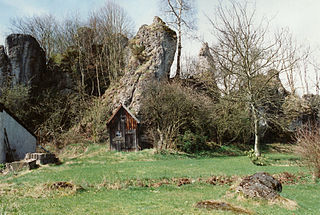
The burgstall or site of Bieberbach Castle is a ruined mediaeval spur castle at a elevation of 530 m above sea level (NN) on a rock formation in the southern part of the parish of Bieberbach, in the market municipality of Egloffstein in the county of Forchheim in the German state of Bavaria.

The burgstall of Wolkenstein Castle is the site of a late medieval aristocratic castle in the village of Wolkenstein, in the borough of Ebermannstadt in the county of Forchheim in the German state of Bavaria. The burgstall is in private hands and may not be visited.

Gaillenreuth Castle is situated high above the Wiesent river on its upper western perimeter in the village of Burggaillenreuth. The village belongs to the borough of Ebermannstadt in the county of Forchheim in the south German state of Bavaria. All that survives is the southern part of the hill castle. As well as parts of the outer ward there is a tower house from the post-1632 period.

Schloss Kunreuth is situated on the northwestern edge of the eponymous village of Kunreuth which is part of the collective municipality of Gosberg in the county of Forchheim, in the province of Upper Franconia in the south German state of Bavaria.

Schloss Wiesenthau stands on the northeastern edge of the eponymous municipality at the foot of the Ehrenbürg in northern Bavaria. The Renaissance building is a three-winged country house with 4 mid-16th century corner towers and the remains of an enceinte.
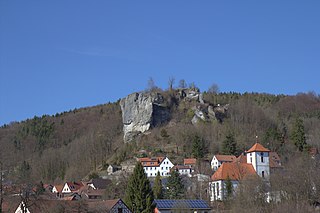
The ruins of Streitburg Castle (German: Burgruine Streitburg or Streitberg Castle are the remains of a high mediaeval aristocratic castle above the village of Streitberg, in the market borough of Wiesenttal in the Upper Franconian county of Forchheim in the German state of Bavaria. They lie directly opposite the ruins of Neideck Castle, the symbol of Franconian Switzerland, on the other side of the valley.



